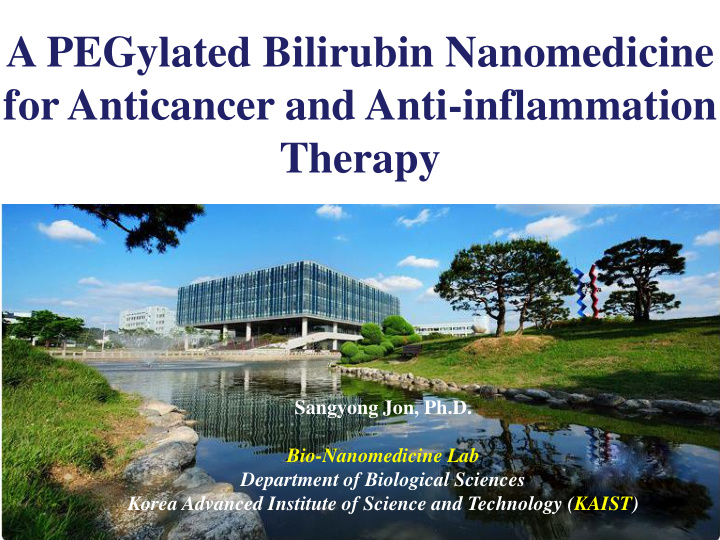



A PEGylated Bilirubin Nanomedicine for Anticancer and Anti-inflammation Therapy Sangyong Jon, Ph.D. Bio-Nanomedicine Lab Department of Biological Sciences Korea Advanced Institute of Science and Technology (KAIST)
Bilirubin? A Final Metabolite of Heme yellow, bile pigment ( ~ 1 mg/dL blood) http://www.benbest.com/nutrceut/AntiOxidants.html
Bilirubin as a Bad Guy Eyes with Jaundice (liver diseases?) Neonatal jaundice Jaundice itself is not a disease in adults, but rather a sign of certain pathological conditions!
Bilirubin: Water-insoluble Jaundice glucuronyltransferase More water soluble X ‘Conjugated’ Bilirubin in the liver ‘Unconjugated’ Bilirubin (BR) Hydrophobic, Water insoluble! (yellow colored pigment) Eyes with Jaundice Deposition in various tissues Display ‘Jaundice’ signature (skin, whites of the eyes (sclera), etc)
Epidemiological Study ( 역학조사 ) on Bilirubin • In 1929, Philip Hench, a rheumatologist, made a dramatic observation, correlating relief of incurable symptoms of rheumatoid arthritis with the onset of jaundice. Gilbert syndrome and Ischemic heart disease: a protective effect of elevated bilirubin Atherosclerosis (2002) Vol. 160:449 – 456. Inverse Relationship between serum bilirubin and atherosclerosis in men Exp Biol Med. (2003) Vol. 228(5):568-571. Serum bilirubin and inverse correlation with colorectal cancer Hepatology (2004) Vol.40: 827- 835. Bilirubin as a Protective Factor for Rheumatoid arthritis J Clin Med Res (2010) Vol.2(6):256-260. Relatively higher levels of bilirubin were associated with a lower risk of respiratory disease and all- cause mortality JAMA. (2011) Vol. 305(7):691-697.
Bilirubin: A Potent Anti-oxidant in Vivo
‘Jekyll & Hyde’ Character ‘ Double-edged Sword ’
PEGylated Bilirubin Bilirubin PEG 2000 -Bilirubin Bilirubin Amphiphillic, Water miscible! Hydrophobic, Water insoluble! Little chance to be remained or accumulated in the body!
Bilirubin Nanoparticles (BRNPs) EDC, mPEG 2,000 -NH 2 DMSO PEGylated bilirubin Bilirubin (PEG-BR) Self-assembly SEM TEM 0.5 m m 200 nm 100 nm Bilirubin nanoparticles (BRNPs)
ROS & Inflammatory Diseases BR BR NPs NPs Dru rug re rele lease Ant ntio ioxid idant ef effe fect ROS ROS Myocardia iac Rat brain Rat rain isch chemic ic infa nfarctio ion mod odel strok st roke mod odel Acu cute or or Chr Chronic ic Asthma mod odel Ano nother r mechanis ism Drug Dr released from BR NPs by ROS stimulus
Bilirubin Nanoparticles: Universal anti- inflammatory therapeutics without immune suppression? 1) Inflammatory Bowel Disease: Acute colitis model ( Angew Chem Int Ed. , 2016) 2) Hepatic ischemia-reperfusion injury: Liver transplantation model ( Biomaterials , 2017) 3) Islet xeno-transplantation ( Biomaterials , 2017) 4) Acute asthma ( Biomaterials , 2017)
BRNPs: ROS/Light-responsive Drug Delivery Carriers as well as a Medicine!
Phototherapy for Neonatal Jaundice blue light ~ 450 nm
Bilirubin Metabolism During Phototherapy Increased solubility! Increased solubility! Water insoluble!
Light-triggered Disruption of BRNPs Light Bilirubin (water insoluble) Photoisomers (water soluble!)
Drug Loading Capability of BRNPs Hydrophilic drug (DOX) in Water Bilirubin PEG-2000 Hydrophilic drug (e.g Distilled 1) Dissolved water or PBS) elimination in CHCl 3 By column separation Hydrophilic Drug (Doxorubicin) 2) CHCl 3 Evaporation PEG-BR Hydrophilic Drug film layer Encapsulated Nanoparticles PBN (PBN loaded with DOX) 100 DOX (PBN loaded with DOX) Doxorubicin (Free DOX) 100 % Encapsulation Relative Fluorescence 80 efficiency 9.09 % Drug loading 60 percentage (Maximun 23%) 40 20 0 0 5 10 15 20 25 Fraction (1 per 2ml)
Light-Induced Disruption of BRNPs (450nm) Photo irradiation for 1 min at 450 nm Light-induced drug release profile (10 mW/cm 2 ) 100 1.1 nm 122.4 nm 80 % Species 60 40 20 DTX 0 0 2 4 6 8 10 Time (min)
Light-Induced Disruption of BRNPs (650nm) Photo irradiation for 1 min at 650 nm Light-induced drug release profile (90 mW/cm 2 ) 100 0.96 nm 98.9 nm 80 % Species 60 40 20 DTX 0 0 2 4 6 8 10 Time (min)
Cancer Targeting Ability of BRNPs Xenograft model : Human lung adenocarcinoma epithelial cell line (A549) in Balb/c nude mice Dose: BRNPs (600 μ g) in PBS, I.V injection Control group: PBS BNVs group Control Heart Tumor Tumor Heart Liver Liver Spleen Spleen Kidney Kidney Lung Lung
Antitumor Efficacy of BRNPs in Vivo Mouse : Balb/c nude mouse 7 weeks Tumor : A549 Human lung carcinoma cell line (1*10^6) Group : Control group (PBS), DOX (2mg/kg), BRNPs (20mg/kg), DOX(2mg/kg)/BRNPs (20mg/kg), DOX(2mg/kg)/BRNPs (20mg/kg) with laser [Laser : 650nm laser (5min, 200 mW/cm 2 ) 30 min after injection of Dox loaded BRNPs] Dosing schedule : 0, 3, 6, 9,12 days Control 500 DOX (2mg/kg) 110 BRNV itself (20mg/kg) DOX loaded BRNV Tumor volume (mm 3 ) DOX loaded BRNV with light 100 400 % Body Weight *: p<0.01 90 300 #: p<0.05 80 200 ##: p<0.05 Control DOX 70 BRNV 100 DOX loaded BRNV DOX loaded BRNV with light 60 0 5 10 15 20 25 30 0 5 10 15 20 25 30 Day Day
Tumor microenvironment & nanomedicine Adapted from Overchuk M. and Zheng G., Biomaterials , 2018.
Tumor microenvironment & ROS ROS are overproduced in the TME! Adapted from Zhang Y. et al., Oxidative Medicine and Cellular Logevity , 2016.
Bilirubin: A Redox Active Compound Water insoluble! More water soluble! yellowish pigment greenish pigment
ROS-triggered Disruption of BRNPs ROS Bilirubin (water insoluble) Biliverdin (increased water solubility)
ROS-triggered Disruption of BRNPs Upon oxidation by peroxy radicals 0 min 10 min 60 min 60 min 1.5 nm 37.8 nm 0 min (N.D.) The size of BRNPs drastically decreased! Solution color of BRNPs became changed
bt-BRNPs as a TME ROS-targeting nanomedicine
Preparation of ROS-responsive bt-BRNPs
Cell targeting and drug release of Dox@bt-BRNPs
Tumor targeting of Cyp@bt-BRNPs
Antitumor Efficacy of BRNPs in Vivo Adv. Science, 2018.
Recommend
More recommend